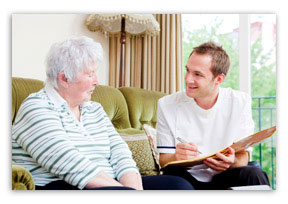Q&A with Jim Judge, chair of the American Red Cross’ Disaster Health Subcommittee
Emergencies and disasters can strike in the blink of an eye, and everybody needs to be prepared. But older adults often have special needs. In this interview, Jim Judge, EMT-P, CEM, a member of the American Red Cross’ Scientific Advisory Council and chair of the organization’s Disaster Health Subcommittee, provides the Get Ready campaign with information on how to help seniors and caregivers prepare for emergencies. A 37-year veteran of the emergency medical services field, Judge serves as executive director of Lake-Sumter EMS in Mount Dora, Fla., and is a member of the Florida Emergency Medical Services Hall of Fame.
 About three-quarters of the people who perished in Hurricane Katrina were older than 60. More recently it was Japan’s oldest residents who were hit hardest as a result of the recent earthquake and tsunami. Why are seniors more vulnerable in emergencies?
About three-quarters of the people who perished in Hurricane Katrina were older than 60. More recently it was Japan’s oldest residents who were hit hardest as a result of the recent earthquake and tsunami. Why are seniors more vulnerable in emergencies?
That’s a great question and you’re absolutely correct. Seventy-five percent of the deaths during Hurricane Katrina were senior citizens, and of course we all saw the news and the effects that it had on Japan. Around the world, our population is aging rapidly. Right now, one out of every 10 persons is 60 years or above, and many of our seniors have physical disabilities or conditions that affect their mobility (and) their agility. During an emergency, it may be difficult or even impossible for some seniors to evacuate quickly. Many use wheelchairs. They have walkers. They have trouble seeing, hearing, understanding and they might misunderstand the emergency instructions. That’s where special measures need to be taken to ensure that our seniors do evacuate safely or have the proper information for them to be able to weather whatever the storm might be.
What are some common-sense measures that older Americans can take to start preparing for emergencies before they happen?
First off, get informed. Find out about what assistance may be available in the local community — through the local chapter of the American Red Cross or through the local emergency management agency. Find out if in fact the community has special shelters designated for their care, which we call “special needs” shelters. Many of these shelters are medically staffed (and) medically equipped. In many communities, even transportation is provided to move residents at high risk to these facilities, where they can be cared for. So getting informed about what services are available in the community is absolutely a priority. Then, make a plan, and the plan obviously includes family members or caregivers. Are you going to shelter-in-place? Are you going to evacuate? Lots of decisions need to be made, and it needs to be done with either the care attendants, with friends (or) with relatives to make sure that the plan is inclusive of what that individual is going to do. I can’t tell an individual what they should do but we do try to provide information that folks can use to help make their individual decisions.
Once you’re informed and you have a plan, then you want to get your emergency kit together. You want to put your supplies that you’re going to use to either shelter-in-place or if you are going to evacuate — things that you’re going to need to have either in your home or to take with you to either a friend’s home or to an emergency shelter.
What are some of the items that people should take with them when they evacuate?
Certainly you want to take some water — generally it’s about one gallon per person per day. Food — nonperishable, easy-to-prepare items. Have a flashlight. And one of the most important (items) is a battery-powered or hand-crank radio so that you can monitor the weather and monitor the public safety information that’s being presented out to the community. Extra batteries. A first aid kit is also going to be important. And also medications — an individual’s medications for at least a week if not for a couple of weeks is going to be the best to have on board. Even a simple thing such as a can opener. A cellphone if you have one, and make sure that it’s fully charged. Have a blanket (and) some maps of the area but also tailor your kit for your own individual needs such as hearing aids, extra glasses, contact lenses, whatever you need individually to sustain your health and your well-being for a period of at least a week.
Are there some special things older adults need to ensure are in their kits?
Absolutely, and there’s a great list on the American Red Cross website. If someone wanted to be “Red Cross Ready,” there is a lot of information there that an individual can review to make sure they have a comprehensive kit of supplies.
 Let’s imagine that a massive ice storm hits your town, resulting in a power outage that lasts a week. How can seniors and caregivers plan in advance for such an event?
Let’s imagine that a massive ice storm hits your town, resulting in a power outage that lasts a week. How can seniors and caregivers plan in advance for such an event?
That’s a good point and again we’ve certainly had that the last few years around the country. But some of the things that they need to prepare are, again, flashlights, making sure that they’re planning for those power outages. Flashlights are best, even if you have some sort of a battery-powered table lamp it’s certainly going to be much safer than using candles. Food — make sure that you have nonperishable food that would last a few days. Canned goods are good for long-term storage and again, a can opener. Blankets, warm clothing and of course the individual can layer, if the power is out and heating is a problem, the individual can layer their clothes. Of course you want to be very careful not to try to heat the home with a barbeque grill or even make a fire inside the home for heat — that can be very dangerous. Also, make sure that you maintain contact with family members so that they know that you are staying home, what your situation is prior to the storm approaching.
Watch the weather reports, listen to the radio and follow any advice that may be given to the local community. When the storm hits, have a fire or furnace running to keep you warm, but again, something that’s approved for inside the home. Stay warm. If you can drink hot liquids and eat hot foods, that’s also going to help maintain your body temperature and help you get through that event.
If you or a loved one resides in a senior community such as a nursing home or an assisted living community, what steps should you take to ensure that the facility is prepared for any kind of emergency? What can you do to make sure the facility is prepared?
That’s great advice, and you speak from experience. You’ve worked in emergency management for almost four decades.
Yes, I have (and) having been through quite a few local events — we’ve had significant tornado events here in our area (and) we’ve had hurricanes. I’m located in central Florida but I’ve also traveled to Katrina (sites) and assisted in the recovery there and also after Hurricane Andrew. And really a lot of the planning for the elderly occurred after Hurricane Andrew, where we saw that many special needs programs weren’t in place, not only in South Florida but even across the country. Communities across America, the Federal Emergency Management Agency and of course the American Red Cross have all been working in the local Red Cross chapters and across the country to educate the public to make preparations with local emergency management agencies that we not only look after the 30-something and the 40-something, but (that) we also look after the 60-plus-something adults and make sure that everyone’s needs can potentially be cared for in some type of a catastrophic event.
I have been through a number of different types of storms, and one of the things here in Florida that we see is that people don’t plan — they don’t prepare — and there’s nothing more amazing to me than when a hurricane is approaching the coast and the lines at Lowe’s and Wal-Mart are miles and miles long with people trying to get the basic supplies, trying to get plywood and things that they could have gotten a week earlier with a 30-minute trip to the store. So make sure that you not only have a plan but that you maintain a kit and that you have these provisions on hand. You never know when a disaster is going to strike, so being proactive, having these things in place, planning for these types of events, are going to help the individual get through it. The local emergency services are going to respond, the state is going to respond, the American Red Cross is going to respond, but in a big event…it’s going to take a few days for these resources to mobilize to be able to get in to provide that assistance. So having that individual person, having that family being more prepared is only going to help them sustain themselves until help can arrive.
What other advice do you have?
I would refer everyone to the American Red Cross website for a lot of information. There’s everything from a winter storm checklist to handling pets…There are earthquake checklists. There’s even information on the flu. So there is a great deal of information that is at someone’s fingertips. And it’s always best to review it now before something happens, to be prepared in the event that you face some type of a weather- or man-made-related emergency.
— Interview conducted, edited and condensed April 2011 by Teddi Dineley Johnson, The Nation’s Health, APHA. Posted July 13, 2011.